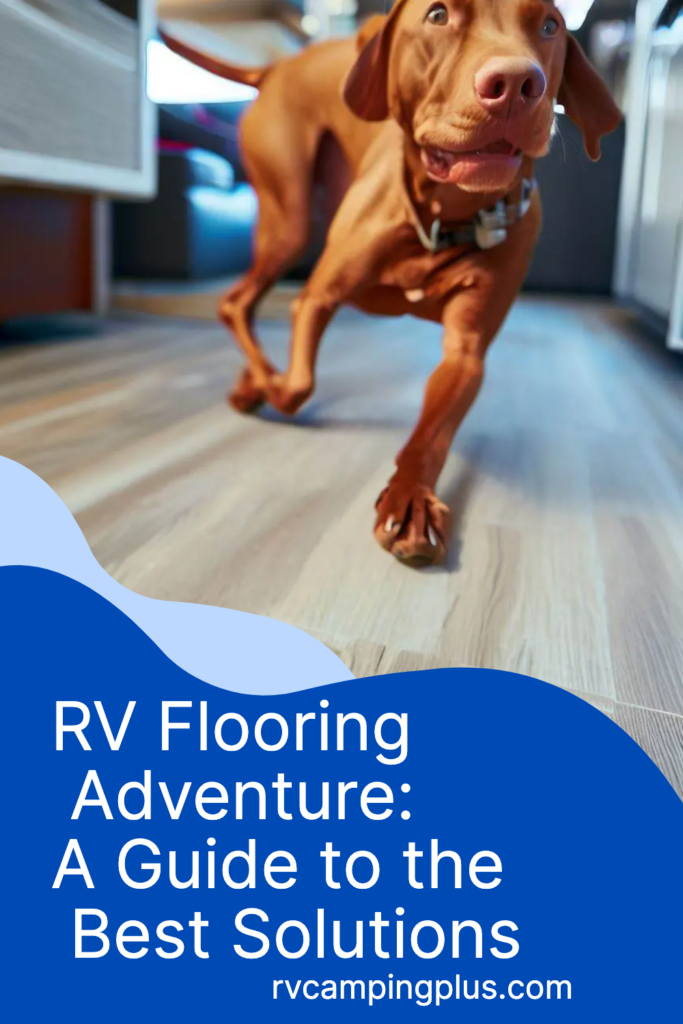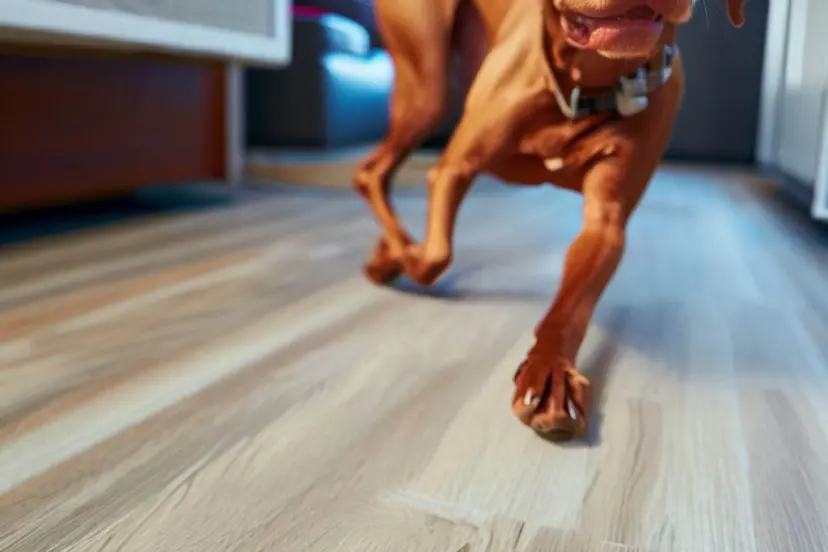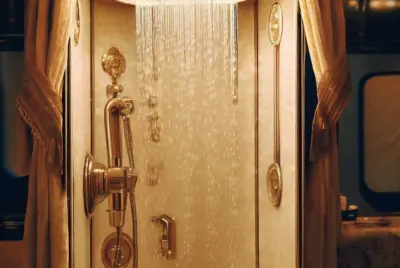Revamp Your Ride: The Ultimate Guide to Choosing and Installing RV Flooring for Style, Comfort, and Resale Value
Embarking on the RV Flooring Adventure: Unraveling the Best Solutions
As we venture into the exciting realm of RV living, one key aspect that often shapes our experience is the choice of RV flooring. Like the sturdy bricks of a stationary home, the floor of your moving abode significantly impacts the feel and functionality of your space. In this comprehensive guide, we delve into the various aspects of choosing and maintaining flooring in your RV, providing affordable, durable, and eco-friendly solutions to transform your motor home, fifth wheel, or toy hauler into a unique charm on wheels.
With the new RV flooring under your bare feet, every road trip will take on a new dimension. We explore popular RV flooring options, ranging from the rustic look of real hardwood floors to the easy installation of vinyl plank flooring. Our step-by-step guide will demystify the installation process, making it an achievable DIY project, even for those on a tight budget. We’ll even discuss how a simple change like replacing old flooring can make a huge difference to your RV’s overall appeal and resale value.
From laminate options to wall-to-wall carpeting, each flooring material holds unique advantages. The warmth of carpet flooring is undeniably inviting, while vinyl’s water resistance and durability make it a smart choice for humid climates or high-traffic areas. You’ll discover that your flooring option isn’t just about aesthetic appeal; it’s about your RV lifestyle, from easy clean-up after a long day at your favorite RV travel destinations to the cozy feel of hardwood underfoot as you sip your morning coffee.
But that’s not all. I’ll guide you through cleaning and maintaining your flooring, from real wood to tile, ensuring its longevity. Furthermore, we present solutions for special circumstances, such as pet-friendly options and lightweight solutions. Plus, we explore green flooring materials for those aiming for an eco-friendly RV life.
The Most Durable Types of RV Flooring: A Definitive Guide
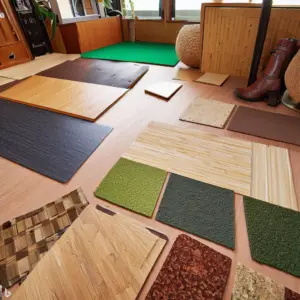 It’s an integral part of any road-tripper’s adventure, as the right choice can make all the difference in durability, comfort, and aesthetics. Let’s dive right in and explore the toughest options that are up to the challenge of the open road!
It’s an integral part of any road-tripper’s adventure, as the right choice can make all the difference in durability, comfort, and aesthetics. Let’s dive right in and explore the toughest options that are up to the challenge of the open road!
The Unbeatable Durability of Luxury Vinyl
First, when discussing durability, luxury vinyl takes the crown. As one of the best replacement flooring options, luxury vinyl is impressively tough, resisting scratches, dents, and stains. These characteristics make it the go-to flooring option if you’ve got kids or pets on board. In a world where pebbles sneak into your RV via shoes, and accidental spills are common, luxury vinyl is a reliable savior.
The Classic Elegance of Laminate Planks
Then there are the laminate planks. Mimicking the look of real wood flooring, laminate is highly resistant to wear, making it a great choice for high-traffic areas in your RV. When replacing flooring, laminate planks offer the perfect blend of durability and aesthetic appeal, adding a cozy, homely feel to your home on wheels. Remember though, laminate might not be your best friend in areas prone to moisture, such as the bathroom or kitchen.
Vinyl Plank and Tiles: The Balance of Strength and Style
Looking for an alternative that’s as sturdy as it is stylish? Consider vinyl plank or vinyl tiles. This flooring material is not just robust and easy to maintain, it also offers a wide variety of patterns and designs. Whether you’re aiming for a classic hardwood look or a sleek modern style, there’s a vinyl plank or tile that matches your aesthetic.
Tile: A Stylish Choice
Tile flooring is another option that deserves mention. It is exceptionally sturdy, with some types, like porcelain and ceramic, known for their hard-wearing nature. Tile’s resistance to moisture and easy-to-clean surface makes it perfect for areas like the kitchen and bathroom. You can even find tiles that replicate the look of natural stone or hardwood for an upscale touch. However, it’s worth noting that tile can add considerable weight to your RV, and it may be more prone to cracking compared to other materials, due to the constant movement of the vehicle.
Carpet: Cozy and Comfortable
While not the first choice for many when it comes to durability, carpet can still be a valid option in certain areas of your RV. It offers unmatched softness and warmth, making it ideal for bedrooms. Moreover, it provides excellent noise absorption, which can add to the overall comfort of your RV. Just bear in mind, carpet requires more effort to keep clean, and it may not last as long as some of the other materials mentioned.
Rubber Flooring: A Practical Pick
Rubber flooring might not be the first material that comes to mind when considering RV flooring, but it’s an option gaining popularity due to its unique benefits. Rubber is extremely durable and resilient, making it an excellent choice for high-traffic areas. It’s slip-resistant and easy to clean, offering a practical solution for those rainy days on the road. Furthermore, rubber flooring can also provide additional insulation and noise reduction. However, while practical, it may not offer the same aesthetic appeal as materials like luxury vinyl or laminate planks.
Cork Flooring: A Unique Blend of Comfort and Sustainability
One flooring option that’s been turning heads recently is cork flooring. Renowned for its comfort and eco-friendliness, cork is a highly sustainable choice as it’s sourced from the bark of cork oak trees, which regenerates over time.
Cork flooring offers a unique blend of features, making it an excellent choice. First and foremost, it’s incredibly comfortable underfoot, thanks to its natural softness and flexibility. This same flexibility also lends cork great durability, as it can recover from impressions more quickly than other materials. This resilience is a plus in an RV setting where heavy furniture and frequent foot traffic are commonplace!
Moreover, cork’s natural insulating properties can help regulate the temperature within your RV, keeping it warmer in cold weather and cooler in hot. This could potentially lead to energy savings over time. Cork is also naturally resistant to mold, mildew, and pests, contributing to a healthier RV environment.
Another key advantage of cork is its sound-damping abilities. The cellular structure of cork effectively reduces noise transmission, making your RV travels quieter and more peaceful.
However, while cork has many benefits, it requires a bit more care than other materials. It may need resealing periodically to maintain its water resistance, and it can be susceptible to sharp objects, so care should be taken with pet claws or high heels.
Lightening the Load: Best Lightweight Flooring Options for Your RV
Whether you’re new to RV life or a seasoned camper, the weight of your RV flooring is a critical factor. Opting for lightweight flooring can help improve gas mileage and ease the strain on your vehicle’s suspension. So, let’s talk about some superb lightweight flooring options for your rolling abode.
Understanding Lightweight Flooring Material
When considering flooring in your camper, you must balance weight with durability. Lightweight flooring should be able to handle heavy foot traffic, pet claws, or accidental spills while still helping to keep your vehicle’s total weight down.
Vinyl: The Lightweight Champion
Vinyl takes the crown as the champion of lightweight flooring options. It’s not just light, but it’s also resilient, easy to clean, and affordable. Bonus? Vinyl flooring comes in an array of styles and colors, so you don’t have to sacrifice aesthetics for weight.
Other Lightweight Options to Consider
Laminate is another option to think about. It’s slightly heavier than vinyl but still falls under the lightweight category. Laminate is durable, scratch-resistant, and mimics the look of real wood.
For those considering replacement flooring, cork is a unique, eco-friendly alternative. It’s remarkably light, has a warm and soft texture underfoot, and it’s a great insulator too.
Selection goes beyond just style and durability. Considering the weight of the flooring is an essential step toward maintaining an efficient, well-balanced RV.
Going Green on the Road: Eco-Friendly RV Flooring Options
As an RV enthusiast, I’m passionate about the outdoors, which includes being environmentally responsible. I’m a big fan of eco-friendly choices. These options are not just good for Mother Nature, but they also add a unique touch to your home on wheels. Let’s explore some of these sustainable options!
Understanding Eco-Friendly Flooring
When it comes to eco-friendly flooring in your camper, the key is to look for materials that are sustainable, have low VOC emissions, and, preferably, are recyclable. It’s a way to ensure your love for the open road doesn’t leave a heavy footprint on the environment.
Cork: Nature’s Gift
Cork is one of the leading eco-friendly flooring options out there. Harvested from the bark of cork oak trees (without harming the tree), it’s not just sustainable but also lightweight, warm, and offers a soft cushioning underfoot. The bonus is that it also has excellent insulation properties, helping keep your RV cozy and energy efficient.
Bamboo: Strength and Sustainability
Bamboo flooring is another excellent green choice. Bamboo is a highly renewable resource due to its fast growth rate and incredibly durable, making it a long-lasting flooring solution for your camper. Bamboo’s sleek, natural look is a chic addition to any RV interior.
Going green doesn’t mean sacrificing style or durability. On the contrary, these sustainable options add a unique and mindful touch to your road-bound home, proving that you can tread lightly on the earth, even in an RV!
Creating a Pet-Friendly Paradise: Best RV Flooring for Your Furry Friends
As a pet-loving RVer, I know the importance of having your four-legged companions along for the journey. However, the wrong replacement flooring can make your road trip messy. So, what are the best flooring options for a pet-friendly RV? Let’s dive in.
What Makes Pet-Friendly Flooring Material?
 When selecting flooring in your RV, it’s crucial to consider your pets’ needs and behaviors. The ideal pet-friendly flooring should be durable, scratch-resistant, easy to clean, and comfortable for your pets to walk on.
When selecting flooring in your RV, it’s crucial to consider your pets’ needs and behaviors. The ideal pet-friendly flooring should be durable, scratch-resistant, easy to clean, and comfortable for your pets to walk on.
Vinyl: A Great Choice for Pets
Vinyl flooring is one of the top choices for pet owners. It’s durable, resisting both scratches and stains, and it’s also easy to clean. If your pet has an accident or tracks in mud, a quick wipe down is usually all it takes.
Other Flooring Options for Pets
Beyond vinyl, laminate is another solid choice, boasting similar benefits. Laminate can mimic the look of hardwood without the vulnerability to scratches or damage from pet nails.
If you’re considering replacement flooring, think about rubber. It provides excellent traction, is easy to clean, and offers a soft surface for pets to lay on, making it a comfortable and practical choice.
When your RV companions have four legs, the right flooring can make all the difference. Whether you’re replacing your current flooring or selecting a new vehicle, considering your pets’ needs will lead you to the perfect choice. After all, our pets are part of the family, and their comfort is as important as ours.
Choices boil down to a balance between durability, maintenance, cost, and style. But one thing is for sure: whether it’s the sturdy luxury vinyl, the elegant laminate planks, or the versatile vinyl plank and tiles, there’s a durable flooring option that’s perfect for your RV. Safe travels, and may your adventures be as reliable as your RV flooring!
Understanding the Average Cost to Replace RV Flooring
As an RV enthusiast, nothing thrills me more than the call of the open road. However, just as vital as the journey is ensuring the comfort of my home on wheels. Whether you’re looking to spruce up your RV’s aesthetics or you’re dealing with wear and tear, replacing flooring can sometimes become a necessity. So, what’s the average cost? Let’s delve into the details.
Factors Influencing the Cost of Flooring in Your RV
The cost of new RV flooring installation depends on several variables. The flooring material is, of course, one of the significant cost determinants. From vinyl and laminate to luxury options like real hardwood or tile, prices can vary widely. An economical choice like vinyl could cost as little as $1-$2 per square foot, while higher-end materials might run up to $10-$15 per square foot or more.
Installation: DIY vs. Professional
Another consideration is the installation process. Are you a hands-on DIYer planning to tackle the project yourself? Or do you plan to hire a professional? Naturally, doing it yourself could save you some bucks, but keep in mind that time is also a valuable resource. Professionals might charge anywhere between $1-$10 per square foot, depending on the complexity of the job and your location.
To Sum it Up: A Ballpark Figure
Considering all these factors, the average cost to replace flooring in your RV could range from a few hundred to several thousand dollars. As a rough estimate, you might expect to pay anywhere from $500 to $5000 for an average-sized RV. Remember, though, these are just averages; your actual costs could be lower or higher, depending on your specific flooring option and installation choices.
In the end, it’s all about striking a balance between cost, quality, and personal preference. After all, your RV is your home away from home, and you want it to feel just right.
DIY Guide: Installing New Flooring in Your RV
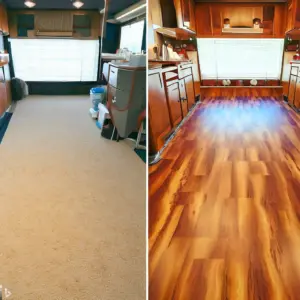 As an RV adventurer, a certain satisfaction comes from taking on projects in your home on wheels. One such project that can significantly upgrade the aesthetics and comfort of your RV is installing new RV flooring. Wondering how to take this on by yourself? Let’s journey through the process together!
As an RV adventurer, a certain satisfaction comes from taking on projects in your home on wheels. One such project that can significantly upgrade the aesthetics and comfort of your RV is installing new RV flooring. Wondering how to take this on by yourself? Let’s journey through the process together!
Choosing the Right Flooring Material
Your first step is to choose the right flooring material. The selection depends on your budget, the look you’re going for, and the use and traffic your floors will see. Each flooring option offers different advantages, from vinyl and laminate to more luxurious options like hardwood or tile. Consider factors like durability, maintenance, and weight – remember, extra weight can affect your RV’s fuel efficiency.
Preparation: Out with the Old, In with the New
The next step involves removing the old flooring. This process can be time-consuming, particularly if the existing material is glued down or there are many nooks and crannies to work around. Be sure to remove any furniture or fittings that might get in the way, and take your time to ensure a smooth, clean surface for your new flooring.
Installing Your Replacement Flooring
Now comes the exciting part – replacing flooring. Start from the center and work your way out to the edges, carefully measuring and cutting your material as you go. Whether you’re laying down planks or tiles, ensure they fit snugly against each other to create a seamless finish.
Finally, replace any trim or molding, reinstall your furniture, and voila!
While the process may require some time and elbow grease, installing your own RV flooring is a project that’s well within reach for most RV owners. Plus, there’s nothing quite like the satisfaction of a job well done, particularly when you can enjoy the fruits of your labor on your next road trip adventure.
Maintaining the Sparkle: Cleaning and Caring for Your RV Flooring
Venturing out on the open road with your RV is a thrilling experience, but taking care of your home on wheels is equally crucial. One essential part is maintaining the new flooring. Proper cleaning and care keep your flooring looking new and extends its lifespan. Let’s explore some practical tips to do it right.
Cleaning Different Flooring Materials in Your RV
The cleaning routine for your new flooring primarily depends on the flooring material.
Vinyl and Laminate
Regular sweeping or vacuuming helps keep dirt and dust at bay for vinyl or laminate floors. A damp mop with a mild cleaner is typically all you need for a deeper clean. Remember to avoid soaking the floor or using abrasive cleaners that could damage the surface.
Hardwood
If you’ve opted for the luxury of real hardwood flooring, it requires a bit more TLC. Use a dust mop or vacuum for daily cleaning, and for a deeper clean, use a specially designed floor cleaner. Even though the material may be water resistant, avoid using water, which can seep into the wood and cause water damage.
Carpet
Carpeted areas in your RV demand regular vacuuming to remove dust and dirt. Spot cleaning can handle small stains, but consider using a carpet cleaning machine or hiring professional services occasionally for a thorough clean.
Preserving Your Flooring Option
Proper maintenance can extend the life of your flooring. Use doormats at entrances to limit dirt tracked in, and consider using protective pads under heavy furniture to prevent indentations. If you notice any damage, consider replacing flooring sooner rather than later to prevent the issue from escalating.
In summary, maintaining and cleaning your RV flooring depends on the type of material you have. Regular care and timely maintenance can help ensure your RV’s interior continues to be inviting, comfortable, and ready for many more adventures. Here’s to keeping your home on the road in top-notch condition. Happy travels!
Resale Value: What’s the Connection?
I understand that your home-on-wheels isn’t just about the now—it’s also an investment for the future. So, when it comes to RV flooring, it’s natural to wonder how it impacts your vehicle’s resale value. Let’s break down the connection.
The Impact of Flooring Material on Resale Value
The flooring material you choose for your RV can influence its resale value. Higher-end options like hardwood or luxury vinyl may appeal to potential buyers who value aesthetics and durability, potentially boosting your RV’s market worth.
Quality Matters
However, the condition of the flooring in your RV is even more crucial. A beautifully maintained laminate or vinyl floor could be more attractive to buyers than a scratched or damaged hardwood floor. Regular cleaning and prompt replacement flooring when needed can help preserve your RV’s value.
Buyer Preferences: A Key Factor
Different buyers have different preferences. Some might prioritize easy cleaning and durability over luxury, leaning towards vinyl or laminate. Others might be willing to put in the maintenance effort for hardwood’s warm, homey feel. Offering a well-maintained flooring option that appeals to a broad range of buyers can help ensure a better resale value.
While the type of material you choose can influence your vehicle’s resale value, the maintenance and overall condition of the flooring can play an even more significant role. Choosing a floor that suits your style, budget, and maintenance capability and then keeping it in top-notch condition can be a smart strategy for RV ownership. After all, the journey should be as enjoyable as the destination.
Warming Up Your RV: Heated Flooring Options
As an RV camping aficionado, I’ve experienced firsthand the chill of a cold RV floor on a winter morning. This discomfort might have you wondering, “Can I use heated floors in an RV?” Absolutely, you can! Let’s explore the cozy world of heated RV flooring and the best options.
The Feasibility of Heated Flooring in Your RV
Integrating heated flooring in your RV isn’t just a luxury—it’s a game-changer for those cold weather trips. Not only does it provide an extra layer of comfort, but it can also contribute to overall heat distribution within your RV.
Electric Radiant Heating
This flooring option involves installing electric heating elements beneath your floor coverings. It’s efficient, easy to control, and compatible with a variety of flooring materials. Just be aware of your RV’s electrical load when using this system, as it does draw a fair amount of power.
Best Heated Flooring Options
You’ve got choices when it comes to the actual flooring material to pair with heated floors. Ceramic or porcelain tile, for instance, conducts heat effectively and adds a touch of elegance. Luxury vinyl flooring also works well, with durability and easy maintenance as bonuses.
If you’re replacing flooring, why not consider a radiant heating underlay under your existing floor type? This way, you’re adding warmth without changing the flooring you love.
Heated floors in your RV are not just possible, but they’re an upgrade that adds comfort and value. Whether you’re a seasonal RVer aiming to extend your camping season or simply someone who enjoys the comfort of a warm floor, this could be a worthwhile addition to your home on the road. Remember, there’s nothing quite like the cozy feeling of heated flooring on a cold morning in the wilderness.
Navigating Your RV Flooring Journey
The choices ahead might seem less daunting after the journey through the myriad options and considerations for your RV flooring. Be it carpet, vinyl, hardwood, or eco-friendly materials, the perfect flooring option awaits you and your RV. So, grab your tools, slide out the old floor, lay down the new, and breathe new life into your space. Remember, each plank or tile you install isn’t just a part of your RV; it’s a piece of your journey, shaping your RV gear and lifestyle.
Whether you are looking for easy-to-install options, flooring that stands up to your four-legged friends, or materials that lend a unique charm to your tiny home on wheels, this guide is your companion. So, get ready to step onto your new floor and roll into the great, wide open, equipped with the knowledge you need to make your RV feel like a home, no matter where your travels lead you.
FAQs
What is the most cost-effective RV flooring option?
Vinyl is one of the most cost-effective RV flooring options. It’s easy to install, highly durable, water-resistant, and available in a variety of styles that mimic more expensive flooring like hardwood.
Can I use bamboo as an RV flooring option?
Yes, you can use bamboo for your RV flooring. It’s a sustainable, eco-friendly option that’s quite durable. However, it may require extra care compared to other flooring materials, as it’s susceptible to water damage and may warp in fluctuating temperatures.
How often should I replace my RV flooring?
The frequency of replacing your RV flooring depends on the type of material used and how well it’s maintained. Most RV owners average replace their flooring every 5-7 years. However, some flooring options can last up to 10-15 years with excellent care and less wear and tear.
Can I install heated floors in my RV?
Yes, you can install heated floors in your RV. One popular option is radiant floor heating, which can be used with many types of flooring. However, it’s essential to consider the power requirements, installation process, and impact on your RV’s weight.
Is it possible to use ceramic tiles for my RV flooring?
While installing ceramic tiles in an RV is possible, they might not be the best choice due to their weight and fragility. The RV’s constant movement can lead to the tiles cracking or breaking. Instead, consider using luxury vinyl tiles, which are lighter, more flexible, and can mimic the look of ceramic tiles.
